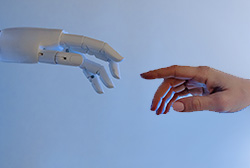
Taking the driver’s seat in the age of robotic vehicles? Education and the AI revolution
‘Innovation and technology’ has to be one of the city’s hottest catchwords in 2018. Over the past few months, many pieces of good news for the academia have come one after another. First, the SAR government pledged to substantially increase local R&D expenditure and identify specific innovation platforms for investment, and put forward plans for recruiting talent from around the world to work in Hong Kong’s tech firms. More recently, the central government affirmed Hong Kong’s position as the Greater Bay Area’s international innovation and technology hub. Hong Kong scientists can now apply for national fundings for research projects in Hong Kong, tax incentives will be granted and technology and entrepreneurial exchanges between Hong Kong and the mainland will be encouraged. All these will be a shot in the arm for all those who work in the innovation and technology sector.
To gain a firm foothold in the fast changing field of innovation and technology, we need to have a robust idea of what innovation is, for this will enable us to know our strengths and weaknesses, think clearly, and scale new heights.

Some time ago, I attended the annual conference of the US National Academy of Inventors. My attention was drawn to a report1 by the US National Academy of Engineering. The report, a consolidation of the views of innovation and technology leaders, defines the four characteristics of innovation:
Innovation is a product, process or service
Innovation has an impact on society
Innovation is an improvement, not just new (the scale can be incremental or transformational)
Innovation is a team activity
A university is a generator and concentrator of new ideas and knowledge, and we as educators are responsible for guiding, nurturing, and consolidating the entrepreneurial spirits of our students. The definition of innovation above in fact echoes the mission of CUHK: ‘To assist in the preservation, creation, application and dissemination of knowledge by teaching, research and public service in a comprehensive range of disciplines, thereby serving the needs and enhancing the well-being of the citizens of Hong Kong, China as a whole, and the wider world community.’
Since its establishment, the University has always stood by its pledge ‘to combine tradition with modernity; to bring together China and the West’ and its motto ‘through learning and temperance to virtue’. Through general education and whole-person education, CUHK aspires to transform its students into well-rounded individuals distinguished by their personal achievements and contributions to society. This mission is particularly important in view of the rapid pace of technological changes that are taking place. Innovation does not mean we should relinquish our tradition; in fact, it is critical that we abide by the humanistic spirit and moral values that we treasure. Innovation is teamwork, that is ideally the consequence of multidisciplinary approaches guided by a global outlook and focused on intercalating issues. Understanding and appreciating the needs of society will guide technological innovations towards positive changes to promote public good.

I have full confidence in Hong Kong’s innovation and technology development, and I am glad to report that it is taking off at the right time, at the right place, and with the right people. I am confident that, by maintaining our competitiveness and focusing on global opportunities, the technological innovations happening here will transform the label, ‘Made in Hong Kong’, into a symbol of outstanding excellence on the global stage.
1National Academy of Engineering. 2015. Educate to Innovate: Factors That Influence Innovation: Based on Input from Innovators and Stakeholders. Washington, DC: The National Academies Press